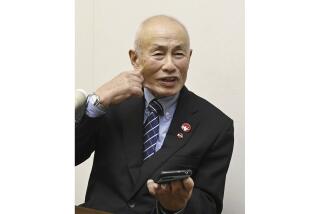From Mouths of Babes: Give Peace a Chance
- Share via
BOGOTA, Colombia — Jenny Campo was 8 years old when soldiers mistakenly attacked her family’s adobe hut in Bolivar province, killing her parents and baby brother.
For a week, the killers held her and her two sisters in the hovel with the bodies, interrogating them unsuccessfully for evidence that their parents were guerrilla supporters.
Five years later, Jenny is a leader in the Children’s Movement for Peace, which has been nominated for the Nobel Peace Prize. The winner will be announced Friday.
“The prize has been given before to organizations that work with children, but never to the children themselves,” said Jose Luis Campo, Jenny’s adoptive father and one of the adults who provides logistic support for the group.
The Colombian children were nominated by 1996 Nobel laureate Jose Ramos-Horta, a former left-wing guerrilla honored for working peacefully to seek East Timor’s independence from Indonesia. The children’s movement, among 139 individuals and groups nominated this year for the prize, was chosen because of its active role in pushing this country to end more than three decades of civil war.
“It has been very satisfying to set goals and accomplish them,” said Jenny, a sixth-grader.
The children have set themselves ambitious goals. First, two years ago, they initially drew 2.3 million youngsters ages 7 to 18 to vote in a referendum for peace. Asked to choose the most important among 12 rights that the United Nations outlines for children, 617,385 kids voted for life and 465,274, for peace--the first and second choices.
Because of budget limitations, the vote was conducted in only about one-third of Colombia’s more than 1,000 townships. But in the weeks after the official poll, done with the help of the nation’s registrar of voters, ballots poured in from children in 200 more townships. They had cut sample ballots from newspapers or photocopied them from the backs of pamphlets. The later ballots added 400,000 to the vote total, but the proportion remained the same, according to the United Nations Children’s Fund, or UNICEF, which helped coordinate the vote.
That was the beginning of a movement.
Andres Alberto Leon, 13, remembers going out on election day to encourage children to vote.
“I felt as if I could do something,” he said. “Our country is crying out for someone to help it. Not only the politicians have solutions for the conflict. There is another alternative: us.”
The children’s mandate for peace thus encouraged a new concept--citizen involvement--in Colombia’s long conflict, UNICEF spokeswoman Clara Marcela de Ayerbe said.
“Before, the government and the guerrillas were the only valid actors” who could end the fighting, she said. “This has changed the process. . . . The children have opened up the field to adults. Common people have begun to demand a solution to the conflict.”
And the children have not let up.
In July, 50 of them participated in the National Civil Society Assembly, a convention of civic groups seeking more citizen involvement in Colombia. The children’s commission gave an oral presentation, “The Country We Want and What We Promise to Do to Build It.” It received a standing ovation.
Friday, children ages 5 to 15 held a regional conference in the city of Villavicencio to elect five representatives to a national convention for peace, being held later this month in the capital, Bogota. Villavicencio, at the edge of Colombia’s rich Eastern Plains, is the latest focus of the fighting that moves like a brush fire through Colombia’s lowlands, driving people from their homes first in one area, then another.
Children attending Friday’s meeting came from areas where fighting is taking place and massacres have occurred in recent months, as well as elsewhere in the Eastern Plains, Jose Luis Campo said.
Said eighth-grader Lelys Restrepo: “We may feel fine here [in Bogota], but children outside [the city] are being scarred by war.” Like Jenny and Andres, Lelys is among the 23 children on the council, the elected representatives of the Children’s Movement for Peace.
Council members represent organizations such as the Red Cross, World Vision, Boy Scouts and several schools. The council meets weekly to direct the movement.
“They are the protagonists; we adults just provide technical support,” Jose Luis Campo said. “What is clear is that the children have a commitment.”
His daughter stated that commitment succinctly: “We cannot just wait around for the country to change,” she said. “We have to change it.”
More to Read
Sign up for Essential California
The most important California stories and recommendations in your inbox every morning.
You may occasionally receive promotional content from the Los Angeles Times.













